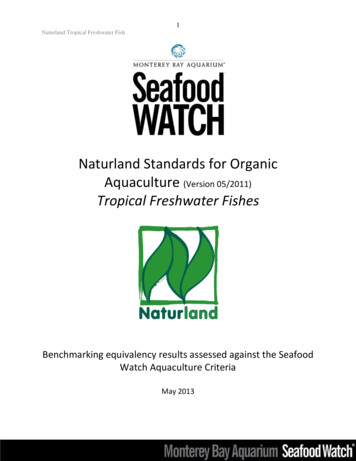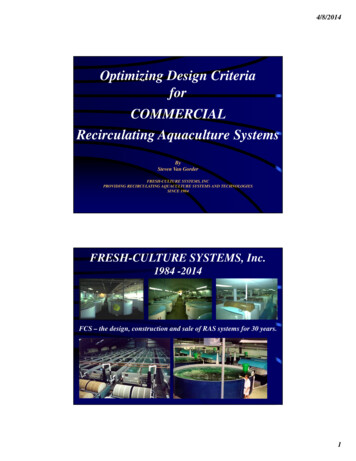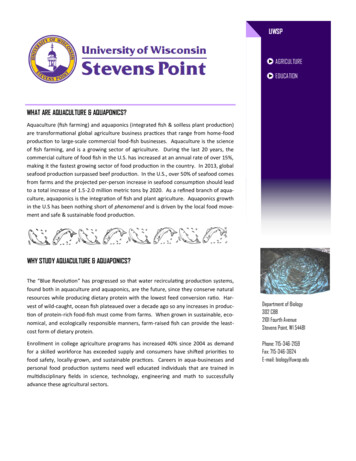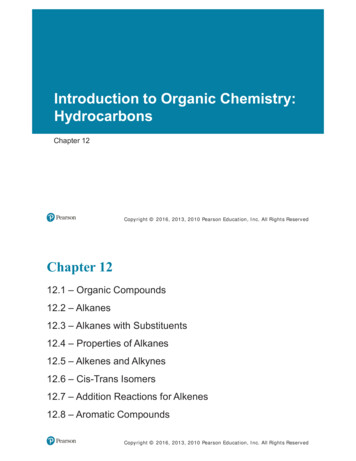
Transcription
1Naturland Tropical Freshwater FishNaturland Standards for OrganicAquaculture (Version 05/2011)Tropical Freshwater FishesBenchmarking equivalency results assessed against the SeafoodWatch Aquaculture CriteriaMay 2013
2Naturland Tropical Freshwater FishFinal Seafood RecommendationNaturland Standards for Organic Aquaculture – Freshwater FishesCriterionScore ELLOWYELLOWGREENGREENREDYELLOWGREENCritical?3.3X Wildlife mortalities6.2X Introduced species escape-2.000.00GREENGREENNOTotal52.54Final score6.57C1 DataC2 EffluentC3 HabitatC4 ChemicalsC5 FeedC6 EscapesC7 DiseaseC8 SourceFinal ScoreInitial rankRed criteriaFinal rankCritical Criteria?NONONONONONO6.57YELLOW1YELLOWNOFINAL RANKYELLOWScoring note – scores range from zero to ten where zero indicates very poor performance andten indicates the aquaculture operations have no significant impact, except for the twoexceptional “X” criteria for which a score of -10 is very poor and zero is good.SummaryThe Naturland Standards for Organic Aquaculture, assessed for tropical freshwater fishes, havea final numerical score of 6.57 out of 10, and with one red criterion (escapes) the final result is ayellow “Good Alternative”.
3Naturland Tropical Freshwater FishExecutive SummaryThe benchmarking equivalence assessment was undertaken on the basis of a positiveapplication of a realistic worst-case scenario. “Positive” – Seafood Watch wants to be able to defer to equivalent certification schemes “Realistic” – we are not actively pursuing the theoretical worst case score. It has torepresent reality and realistic aquaculture production. “Worst-case scenario” – we need to know that the worst-performing farm capable of beingcertified to any one standard is equivalent to a minimum of a Seafood Watch “Goodalternative” or “Yellow” ranking.The assessment was conducted for tilapia in cages as a worst-case scenario for the species andproduction systems covered within the scope of the standards. The final result of theequivalence assessment for Naturland Standards for Organic Aquaculture for tropicalfreshwater fish is a yellow ”Good Alternative” recommendation. Seafood Watch does notconsider all certified farms to be at that level, but the standards could allow a farm equivalentto a yellow Seafood Watch recommendation to be certified. This means Seafood Watch candefer to Naturland Freshwater Fishes certification as an assurance that certified products meetat least a yellow “Good Alternative” recommendation.In general, the Naturland Standards for Organic Aquaculture for freshwater fish: contain overview requirements for all species and production systems certified under thestandards (under Part A and Part B- Section I) contain species-specific and production-specific standards (under Part B- Sections II throughVII) frequently use terms such as “ prefer” or “minimize” which have no value in certification have few specific requirements for tilapia in cages like all farm-level certification standards do not robustly control cumulative impacts formultiple neighboring, local, or regional farmsSpecifically for each criterion, the Naturland Organic Aquaculture Standards for tropicalfreshwater fishes: necessitate considerable data collection to demonstrate compliance with the standards,and when combined with the farm-level certification process (ie. audit) result in a high datascore, prohibit effluents from impacting surrounding habitats or ecosystem functionality, yet donot set discrete effluent limits, restrict chemical use and prohibit impacts on non-target organisms, specify a limit on fishmeal inclusion well above current industry norms have no specific escape requirements or limits, certify open production systems that allow the exchange of pathogens and parasites, prohibit the use of wild-caught broodstock, only recommend (i.e. do not require) passive, non-lethal predator deterrents
4Naturland Tropical Freshwater FishTable of ContentsFinal Seafood Recommendation . 2Executive Summary. 3Introduction . 5Scope of the analysis and ensuing recommendation . 5Analysis . 5Scoring guide. 6Criterion 1: Data quality and availability . 7Criterion 2: Effluents . 7Criterion 3: Habitat . 13Factor 3.3X: Wildlife and predator mortalities . 17Criterion 4: Evidence or Risk of Chemical Use . 18Criterion 5: Feed . 19Criterion 6: Escapes . 23Factor 6.2X: Escape of unintentionally introduced species. 25Criterion 7. Disease; pathogen and parasite interactions . 26Criterion 8. Source of Stock – independence from wild fisheries . 27Overall Recommendation . 29References . 32Guiding Principles . 30Data points and all scoring calculations. 32
5Naturland Tropical Freshwater FishIntroductionScope of the analysis and ensuing recommendationThe Naturland Organic Aquaculture Standards consist of general regulations for organicaquaculture (and other forms of organic agriculture) and contain supplemental sections forspecific species groups. This assessment is specific to relevant general standards (Part B –Section I) as well as Part B – Section VI supplementary regulations for the culture of freshwatertropical fishes (ie. milkfish Chanos chanos, tilapia Oreochromis sp., Siamese catfish Pangasiussp.)SpeciesThe assessment focuses on tilapia (Oreochromis sp.) in cages where the species is non-native asa realistic worst-case scenario.Geographic coverageGlobalProduction MethodsPonds and net cagesAnalysisBenchmarking principlesThe benchmarking equivalence assessment was undertaken on the basis of a positiveapplication of a realistic worst-case scenario “Positive” – Seafood Watch wants to be able to defer to equivalent certification schemes “Realistic” – we are not actively pursuing the theoretical worst case score. It has torepresent reality and realistic aquaculture production. “Worst-case scenario” – we need to know that the worst farm capable of being certified toany one standard is equivalent to a minimum of a Seafood Watch “Good alternative” or“Yellow” rank.Benchmarking assumptionsA number of assumptions were made to enable an equivalence assessment to be made eitherin the face of differing language or units etc., or in the case of missing information or gaps inthe standards. The assumptions enable consistency across all the standards being assessed.Specific assumptions have been noted where relevant in the individual criteria sections below,but the following were applied to all standards: Anything referred to as “should”, “recommend”, “prefer”, “minimize”, “minor must” or anysimilarly non-specific language was ignored Any deferral to local or national regulations in a standard of global scope was ignored.
6Naturland Tropical Freshwater Fish Any aspirational intent not supported by robust standards was ignored (for example “Youmust prevent escapes” was ignored if there were not effective supporting standards toactually prevent escapes).Any standards based on a future timeframe were ignored.Assume standards are applicable globally unless the standards or the scheme’s label specifyor differentiate production regions. Assume the worst-case farm is in the worst country orregion.Only “complete” production systems were assessed across all criteria – for example allcriteria for tilapia are assessed for cages because this gives the lowest overall final score andrank, even though ponds would have a lower habitat criterion score.Requirements for animal health plans, veterinary supervision, or veterinary prescription ofmedications were ignored without further robust requirements in the standardsScoring guide With the exception of the exceptional factors (3.3x and 6.2X), all scores result in a zero toten final score for the criterion and the overall final rank. A zero score indicates poorperformance, while a score of ten indicates high performance. In contrast, the twoexceptional factors result in negative scores from zero to minus ten, and in these cases zeroindicates no negative impact. The full Seafood Watch Aquaculture Criteria to which the following scores relate areavailable here 1.The full data values and scoring calculations are available in Appendix 1 1http://www.montereybayaquarium.org/cr/cr seafoodwatch/sfw aboutsfw.aspx
7Naturland Tropical Freshwater FishCriterion 1: Data quality and availabilityImpact, unit of sustainability and principle Impact: poor data quality and availability limits the ability to assess and understand theimpacts of aquaculture production. It also does not enable informed choices for seafoodpurchasers, nor enable businesses to be held accountable for their impacts. Sustainability unit: the ability to make a robust sustainability assessment Principle: robust and up-to-date information on production practices and their impacts isavailable to relevant stakeholders.Criterion 1 Summary of scores for Naturland Tropical Freshwater FishesExplanatory score tables for C1 can be found on pages 3-4 of the Seafood Watch assessmentcriteria.Data CategoryIndustry or production statisticsEffluentLocations/habitatsPredators and wildlifeChemical useFeedEscapes, animal movementsDiseaseSource of stockOther – (e.g. GHG emissions)TotalC1 Data Final ScoreRelevance (Y/N)yesyesyesyesyesyesyesyesYesNo8.61Data Quality Score .5n/an/a77.5GREENJustification of RankingAssumptions: The “Source of stock” and “Energy use” categories were considered “non-relevant” unlessthe scheme specifically required data collection on these aspects. Schemes could improvetheir score by requirements in this respect, but would not be penalized for not providinginformation on what would be considered universal practice.While there are few specific data collection requirements, certification to the standardsnecessitates monitoring and data collection on all aspects relevant to the Seafood Watchcriteria. The lack of specific requirements in many standards means that the data score is only7.5 rather than 10 in many categories.
8Naturland Tropical Freshwater FishThe Criterion 1 (Data) score is 8.61 out of 10.Criterion 2: EffluentsImpact, unit of sustainability and principle Impact: aquaculture species, production systems and management methods vary in theamount of waste produced and discharged per unit of production. The combined dischargeof farms, groups of farms or industries contributes to local and regional nutrient loads. Sustainability unit: the carrying or assimilative capacity of the local and regional receivingwaters beyond the farm or its allowable zone of effect. Principle: aquaculture operations minimize or avoid the production and discharge of wastesat the farm level in combination with an effective management or regulatory system tocontrol the location, scale and cumulative impacts of the industry’s waste discharges beyondthe immediate vicinity of the farm.Criterion 2 Summary of scores for Naturland Tropical Freshwater FishesExplanatory score tables for C2 can be found on pages 8-12 of the Seafood Watch assessmentcriteria.Effluent parametersF2.1a Biological waste (nitrogen) production per of fish (kg N ton-1)F2.1b Waste discharged from farm (%)F2 .1 Waste discharge score (0-10)F2.2a Content of regulations (0-5)F2.2b Enforcement of regulations (0-5)F2.2 Regulatory or management effectiveness score (0-10)Value59.28053566.00C2 Effluent Final ScoreCritical?ScoreYELLOWNOJustification of RankingAssumptions For consistency, the full assessment was used across all species The cumulative impacts questions on regulations and enforcement were assessed accordingto the standards requirements in this respect No fertilizer use was considered unless specified in the standards Tilapia, salmon and cod effluent was assessed for cages, other species were assessed forhigh-exchange ponds as a worst-case scenario unless otherwise specifiedNaturland standard Section VI 2.1 states: “The water quality of source water bodies (in the caseof pond farms) or the surrounding lake or sea regions (in the case of net cages) should not
9Naturland Tropical Freshwater Fishbecome significantly deteriorated (standard value 10% of the parameters determined, seefootnote) due to the farming operation. This shall be secured by sedimentation ponds and/orfiltering plants dimensioned adequately. Settled particulate organic matter (products ofmetabolism, feed residues) shall be removed and brought to adequate re-usage (e.g. asfertilizer in agriculture).”The footnote referred to states: Monitoring and evaluation of macro-zoobenthos (e.g. inaccordance with the index of saprobiontic succession) or measurement of single parameters(ammonia, nitrate, nitrite, phosphate) at the outlet resp. in the immediate vicinity of the netcages, compared with values from reference points above the effluent resp. outside the vicinityof the net cages.For this assessment, the interpretation of the 10% language and how it is applied in reality isambiguous. The remedial measures do not appear to apply to cage farms. Additionally theNaturland Standards for Organic Aquaculture do not have any specific effluent water qualityrequirements. Therefore the full Seafood Watch assessment was used to calculate typicaleffluent characteristics for tilapia farms.Factor 2.1. Waste discharged from the farmThe Naturland Standards for Organic Aquaculture do not have any specific effluent waterquality requirements. Therefore the full Seafood Watch assessment was used to calculatewaste production.Relevant Content of StandardsProtein content of feedNot addressed by initiativeFeed conversion ratioNot addressed by initiativeFertilizer inputHow we applied it30.0% for tilapia from FAO (2010)1.7 for tilapia from Tacon et al (2011)Assumed zero for all benchmarking assessmentsProtein content of whole harvested fish14% for tilapia from Boyd et al (2007)Not addressed by initiativeThese values result in a nitrogen waste production of 59.2 kg per ton of farmed tilapia (seeCriteria – Factor 2.1a for calculations).Factor 2.1b calculates the proportion of the waste produced that is discharged from the farm.
10Naturland Tropical Freshwater FishRelevant Content of StandardsBasic discharge score or percentage of waste dischargedNot addressed by imitativeHow we applied itFrom the Seafood Watch criteria,80% of waste produced by fish innet pens has the potential to impactbeyond the farm AZE.Waste discharge per ton of farmed tilapia (available for impact beyond an allowable zone ofeffect [AZE]) is 47.36 kg. This results in an initial waste score of 5 out of 10 for the 40-50 kgcategory.Factor 2.1 score is 5 out of 10.Factor 2.2. Effluent management effectiveness (appropriate to the scale of the industry)Factor 2.2a assesses the content of the management measures.Relevant Content of StandardsHow we applied itSection I 1.1. By selection of site and the method ofScore of 1 out of 1 for F2.2amanagement of the farm, the surrounding ecosystemsQuestion 1 because the standardshall not be adversely affected. In particular, negativehas set specific regulations andimpact caused by effluents as well as by escape ofcontrol measures that are designedanimals shall be prevented by adopting suitablefor aquaculture.preventive measures.Are the control measures applied according to site-specificScore of 0 out of 1 for F2.2aconditions and/or do they lead to site-specific effluent,Question 2 because the standardsbiomass or other discharge limits?can be universally applied and asNot addressed by initiativesuch no site-specific limits orrequirements are includedDo the control measures address or relate to the cumulativeScore of 0 out of 1 for F2.2aimpacts of multiple farms?Question 3 because the farm-levelNot addressed by initiativecertification has no control over thecumulative impacts of neighboringor multiple farms.Section I 1.1. By selection of site and the method ofScore of 1 out of 1 for F2.2 Questionmanagement of the farm, the surrounding ecosystems4 because the standards requireshall not be adversely affected. In particular, negativethat the ecosystem functionality notimpact caused by effluents as well as by escape ofbe adversely affected by the farminganimals shall be prevented by adopting suitableoperation.preventive measures.Section I 1.3 Through appropriate design andmanagement of the farm areas it shall be ensured thatthe water bodies inside the operation retain theirecological functions depending on the respectivegeographical conditions (e.g. breeding ground foramphibians and water insects, resting place for
11Naturland Tropical Freshwater Fishmigratory birds, migration routes for fish).Section VI 2.1 The bottom of the ponds below the netcages should be regularly inspected for organic depositscaused by excrements and feed residues.Factor 2.2a score is 3 out of 5.Score of 1 out of 1 for F2.2aQuestion 5 because the standardsrequire regular monitoringthroughout the production cycle.Factor 2.2b assesses the enforcement of the above measures.Relevant Content of StandardsPreviously announced (at least once a year) and unannouncedvisits and inspections by personnel authorized by Naturlandshall monitor adherence to the standards. They shall beprovided with unrestricted access and scrutinizing opportunitiesinto all the relevant areas of the farm. Upon request, all thedocuments relating to the managing of the farming operation aswell as any other relevant information shall be made available.How we applied itScore of 1 out of 1 for F2.2bQuestion 1 becauseNaturland identifies whichinspection bodies they workwith and that farms areinspected on a yearly basisNaturland mandates inspection bodies to perform regularinspections of farmers and processors at least once every year.In addition to the annual tours of inspection, unannounced spotchecks are also made. Inspection is performed by external,expert, state-approved inspection bodies. Naturland cooperates primarily with the following respected inspectionbodies:BCS-Öko-Garantie GmbHIMO Institute of MarketecologieLacon GmbH andÖkop-Zertifizierungsgesellschaft mbHThe basis for the decision of the certification committee is theresults determined by and facts presented in the inspectionreport. In cases of non-conformity with the standards, any of alist of penalties ranging from a warning to withdrawal of theright to use the logo and disqualification of the farm may beimposed.Every year the farms receive a new notice of certification and acertificate from Naturland’s certification committee. Theseconfirm that the farm is managed in conformity withNaturland’s standards.Processing enterprises which process raw goods certified byNaturland and require their suppliers to produce correspondingproof of Naturland quality may receive correspondingconfirmation that they do so from Naturland, on request.Score of 1 out of 1 for F2.2bQuestion 2 because ifNaturland standards are notbeing met then there arenumber of potentialpenalties includingdisqualification of the farm
12Naturland Tropical Freshwater Fish6. Documentation and inspectionThe currently valid details (i.e. type and size of the stock, largescale transport of stock, e.g. to net cages located some distanceaway) shall be reported to Naturland. Regarding product flow(e.g. additional purchases of feed as well as the sale of farmproducts), likewise, records shall be kept in accordance withNaturland‟s standards. Furthermore, a farm diary shall be kept(e.g. on the incidence of diseases, mortality rates,implementation of special hygienic measures such asdewatering, liming etc.). An obligation for an immediatereporting shall exist in respect of all such factors that cannegatively affect the quality of the products (e.g. contaminationof water sources, occurrence of toxic algae blooms or „redtides“). Previously announced (at least once a year) andunannounced visits and inspections by personnel authorized byNaturland shall monitor adherence to the standards. They shallbe provided with unrestricted access and scrutinizingopportunities into all the relevant areas of the farm. Uponrequest, all the documents relating to the managing of thefarming operation as well as any other relevant informationshall be made available.All stages of the value chain have to be recorded when the farmis inspected, although, in the case of co- operatives, forexample, individual areas can be organized to conform with theinternal control system (ICS).The basis for the decision of the certification committee is theresults determined by and facts presented in the inspectionreport. In cases of non-conformity with the standards, any of alist of penalties ranging from a warning to withdrawal of theright to use the logo and disqualification of the farm may beimposed.Every year the farms receive a new notice of certification and acertificate from Naturland’s certification committee. Theseconfirm that the farm is managed in conformity withNaturland’s standards.Processing enterprises which process raw goods certified byNaturland and require their suppliers to produce correspondingproof of Naturland quality may receive correspondingconfirmation that they do so from Naturland, on request.Score of 1 out of 1 for F2.2bQuestion 3 becauseenforcement covers theentire production cycle.The basis for the decision of the certification committee is theresults determined by and facts presented in the inspectionreport. In cases of non-conformity with the standards, any of alist of penalties ranging from a warning to withdrawal of theScore of 1 out of 1 for F2.2bQuestion 5 because ifNaturland standards are notbeing met then there areScore of 1 out of 1 for F2.2bQuestion 4 because ifNaturland standards are notbeing met then there arenumber of potentialpenalties includingdisqualification of the farm.
13Naturland Tropical Freshwater Fishright to use the logo and disqualification of the farm may beimposed.Every year the farms receive a new notice of certification and acertificate from Naturland’s certification committee. Theseconfirm that the farm is managed in conformity withNaturland’s standards.Processing enterprises which process raw goods certified byNaturland and require their suppliers to produce correspondingproof of Naturland quality may receive correspondingconfirmation that they do so from Naturland, on request.number of potentialpenalties includingdisqualification of the farm.Factor 2.2b score is 5 out of 5.The final effluent score is a combination of the waste discharged and the effectiveness of themanagement to control the total and cumulative impacts. The table on page 12 of the SeafoodWatch assessment criteria document shows how this score is calculated, producing a final C2score of 6 out of 10.Criterion 3: HabitatImpact, unit of sustainability and principle Impact: Aquaculture farms can be located in a wide variety of aquatic and terrestrial habitattypes and have greatly varying levels of impact to both pristine and previously modifiedhabitats and to the critical “ecosystem services” they provide. Sustainability unit: The ability to maintain the critical ecosystem services relevant to thehabitat type. Principle: aquaculture operations are located at sites, scales and intensities thatcumulatively maintain the functionality of ecologically valuable habitats.Criterion 3 Summary of scores for Naturland Tropical Freshwater FishesExplanatory score tables for C3 can be found on pages 13-16 of the Seafood Watch assessmentcriteria.Habitat parametersF3.1 Habitat conversion and functionF3.2a Content of habitat regulationsF3.2b Enforcement of habitat regulationsF3.2 Regulatory or management effectiveness scoreValue3.504.005.606.53C3 Habitat Final ScoreCritical?Score7.00NOYELLOW
14Naturland Tropical Freshwater FishJustification of RankingAssumptions: Assume farm is in high-value (or former high-value) habitat unless standards specifyotherwise The cumulative impacts questions on regulations and enforcement were assessed accordingto the standards requirements in this respectFactor 3.1. Habitat conversion and functionFactor 3.1 assesses the impact on ecosystem services at the farm site, or within an allowablezone of effect (AZE). Explanatory tables and calculations can be found on page 14 of theSeafood Watch assessment criteria.Relevant Content of StandardsPart B Section l 2.1 The inflowing water shall reveal noneor only slight contamination of anthropogenic origin.The pH- value shall be between pH 6.0 and 9.0.How we applied itScore of 7 due to worst-casemoderate impacts while retaining allecological functions.Part B Section I 1.1. By selection of site and the methodof management of the farm, the surroundingecosystems shall not be adversely affected. In particular,negative impact caused by effluents as well as by escapeof animals shall be prevented by adopting suitablepreventive measures. In the case of installation of newfarms or amplification of already existing, naturalvegetation shall not be dam- aged in a lasting way. Thishas to be respected, in particular, if the type ofvegetation has to be classified, at regional orinternational level, as rare or endangered (e.g. marshareas in Middle Europe; rain forest, mangroves).Part B I 1.3. Through appropriate design andmanagement of the farm areas it shall be ensured thatthe water bodies in- side the operation retain theirecological functions depending on the respectivegeographical conditions (e.g. breeding ground foramphibians and water insects, resting place formigratory birds, migration routes for fish). For thispurpose, in particular, adequately large areas showingnatural vegetation (e.g. water reeds, tall aquatic plants)shall be protected or re-planted by the enterprise.Factor 3.2. Habitat and farm siting management effectiveness (appropriate to the scale of theindustry)
15Naturland Tropical Freshwater FishFactor 3.2a assesses the content of the management measures to manage site-specific andcumulative habitat impacts. See Appendix 1 for scoring questions.Relevant Content of StandardsSection I 1.1 and 1.3 as aboveHow we applied itScore of 0.75 out of 1 for F3.2aQuestion 1 because an EIA is notrequired by this initiative, howeversiting standards require farmingoperations to maintain fullecosystem function.Is the industry’s total size and concentration based on itscumulative impacts and the maintenance of ecosystemfunction?Not addressed by initiativeScore of 0 out of 1 for F3.2aQuestion 2 because the standardsare farm-specific and therefore haveno control over the cumulativeimpacts of neighboring or regionalfarms.Section I 1.1 and 1.3 as aboveScore of 0.75 out of 1 for F3.2aQuestion 3 because althoughongoing and future expansion arenot significantly spoken to directlywithin the initiatives, it is expectedthat any growth of a farm wouldcomply with all previously setstandards.Section I 1.1 and 1.3 as aboveScore of 1 out of 1 for F3.2aQuestion 4 because habitats withhigh levels of ecosystemfunctionality must be avoided.Do control measures include requirements for theScore of 1 out of 1 for F3.2arestoration of important or critical habitats or ecosystem Question 5 because although theservices?standards do not speak toNot addressed by initiativerestoration, F3.2a Question 4indicates that important or criticalhabitats are avoided and as such norestoration is necessary.Factor 3.2a score is 3.5 out of 5.Factor 3.2b assesses the enforcement of the above measures. See Appendix 1 for scoring questions.Relevant Content of StandardsNaturland mandates inspection bodies to performregular inspections of farmers and processors at leastonce every year. In addition to the annual tours ofHow we applied itScore of 1 out of 1 for F3.2bQuestion 1 because farminspections occur at least once
16Naturland Tropical Freshwater Fishinspection, unannounced spot checks are also made.every year. Inspection Bodies areInspection is performed by external, expert, statelisted on the Naturland website.approved inspection bodies. Naturland co-operatesprimarily with the following respected inspection bodies:BCS-Öko-Garantie GmbHIMO Institute of MarketecologieLacon GmbH andÖkop-Zert
Executive Summary The benchmarking equivalence assessment was undertaken on the basis of a positive . tropical fishes (ie. milkfish Chanos chanos, tilapia Oreochromis sp., Siamese catfish Pangasius sp.) Species. The assessment focuses on tilapia . Any deferral to local or national regulations in a standard of global scope was ignored. 6 .










